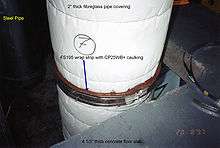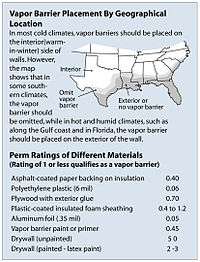Vapor barrier

A vapor barrier (or vapour barrier) is any material used for damp proofing, typically a plastic or foil sheet, that resists diffusion of moisture through wall, ceiling and floor assemblies of buildings to prevent interstitial condensation and of packaging. Technically, many of these materials are only vapor retarders as they have varying degrees of permeability.
Materials have a moisture vapor transmission rate that is established by standard test methods. One common set of units is g/m²·day or g/100in²·day. Permeability can be reported in perms, a measure of the rate of transfer of water vapor through a material (1.0 US perm = 1.0 grain/square-foot·hour·inch of mercury ≈ 57 SI perm = 57 ng/s·m2·Pa). American building codes have classified vapor retarders as having a water vapor permeance of 1 perm or less when tested in accordance with the ASTM E96 desiccant, or dry cup method.[1] Vapor retarding materials are generally categorized as:
- Impermeable (≤1 US perm, or ≤57 SI perm) (Materials such as asphalt-backed kraft paper, vapor-retarding paint, oil-based paints, vinyl wall coverings, extruded polystyrene, plywood, OSB),
- Semi-permeable (1-10 US perm, or 57-570 SI perm) (Materials such as unfaced expanded polystyrene, fiberfaced isocyanurate, heavy asphalt-impregnated building papers, some latex-based paints),
- Permeable (>10 US perm, or >570 SI perm) (Materials such as unpainted gypsum board and plaster, unfaced fiber glass insulation, cellulose insulation, unpainted stucco, cement sheathings, spunbonded polyolefin or some polymer-based exterior air barrier films).
Materials
Vapor diffusion retarders are normally available as coatings or membranes. The membranes are technically flexible and thin materials, but sometime includes thicker sheet materials named as "structural" vapor diffusion retarders. The vapor diffusion retarders varies from all kinds of materials and keep updating every day, some of them nowadays even combined the functions of other building materials.
Materials used as vapor retarders:
- Aluminum foil, 0.05 US perm (2.9 SI perm).
- Paper-backed aluminum.
- Polyethylene plastic sheet, 4 or 6 thou (0.10 or 0.15 mm), 0.03 US perm (1.7 SI perm).
- Advanced Polyethylene vapor retarders that pass the ASTM E 1745 standard tests ≤0.3 US perm (17 SI perm).
- Asphalt-coated kraft paper, often attached to one side of fiberglass batts, 0.40 US perm (22 SI perm).
- Metallized film
- Vapor retarder paints (for the air-tight drywall system, for retrofits where finished walls and ceilings will not be replaced, or for dry basements: can break down over time due to being chemically based).
- Extruded polystyrene or foil-faced foam board insulation.
- Exterior grade plywood, 0.70 US perm (40 SI perm).
- Most sheet type monolithic roofing membranes.
- Glass and metal sheets (such as in doors and windows).

Building construction
Moisture or water vapor moves into building cavities in three ways: 1) With air currents, 2) By diffusion through materials, 3) By heat transfer. Of these three, air movement accounts for more than 98% of all water vapor movement in building cavities. [2] A vapor retarder and an air barrier serve to reduce this problem, but are not necessarily interchangeable.
Vapor retarders slow the rate of vapor diffusion into the thermal envelope of a structure. Other wetting mechanisms, such as wind-borne rain, capillary wicking of ground moisture, air transport (infiltration), are equally important.
Usage
The industry has recognized that in many circumstances it may be impractical to design and build building assemblies which never get wet. Good design and practice involve controlling the wetting of building assemblies from both the exterior and interior.[3] So, the use of vapor barrier should be taken into consideration. Their use has already been legislated within the building code of some countries (such as the U.S., Canada, Ireland, England, Scotland & Wales). How, where, and whether a vapor barrier (vapor diffusion retarder) should be used depends on the climate. Typically, the number of heating degree days (HDD) in an area is used to help make these determinations. A heating degree day is a unit that measures how often outdoor daily dry-bulb temperatures fall below an assumed base, normally 18°C (65°F).[4] For building in most parts of North America, where winter heating conditions predominate, vapor barrier are placed toward the interior, heated side of insulation in the assembly. In humid regions where warm-weather cooling predominates within buildings, the vapor barrier should be located toward the exterior side of insulation. In relatively mild or balanced climates, or where assemblies are designed to minimize condensation conditions, a vapor barrier may not be necessary at all.[5]
An interior vapor retarder is useful in heating-dominated climates while an exterior vapor retarder is useful in cooling-dominated climates. In most climates it is often better to have a vapor-open building assembly, meaning that walls and roofs should be designed to dry:[6] either to the inside, the outside, or both, so the ventilation of water vapor should be taken into consideration. A vapor barrier on the warm side of the envelope must be combined with a venting path on the cold side of the insulation. This is because no vapor barrier is perfect, and because water may get into the structure, typically from rain. In general, the better the vapor barrier and the drier the conditions, the less venting is required.[7]
In areas below foundation level (or, subgrade areas), particularly those formed in concrete, vapor retarder placement can be problematic, as moisture infiltration from capillary action can exceed water vapor movement outward through framed and insulated walls.
A slab-on-grade or basement floor should be poured over a cross-laminated polyethylene vapor barrier over 4 inches (10 cm) of granular fill to prevent wicking of moisture from the ground and radon gas incursion.
Inside a steel building, water vapor will condense whenever it comes into contact with a surface that is below the dew point temperature. Visible condensation on windowpanes and purlins that results in dripping can be somewhat mitigated with ventilation; however insulation is the preferred method of condensation prevention.
Confusion between Vapor barrier and Air barrier
The function of a vapor barrier is to retard the migration of water vapor, which are not typically intended to retard the migration of air. This is the function of air barriers.[8] Air is mixed with water vapor. When air moves from location to location due to an air pressure difference, the vapor moves with it. This is a type of migration of water vapor. In the strictest sense air barriers are also vapor barriers when they control the transport of moisture-laden air.[9] It must be mentioned that the designated perm ratings do not reflect the diminished permeability of a given vapor retarder medium when affected by temperature differences on opposing sides of the medium.[10] A discussion about the differences between vapor barriers and air barriers can be found in Quirouette.[11]
Packaging
The ability of a package to control the permeation and penetration of gasses is vital for many types of products. Tests are often conducted on the packaging materials but also on the completed packages, sometimes after being subjected to flexing, handling, vibration, or temperature.
See also
References
- ↑ Teed, Certain (2006). Smart Vapor Retarders. Certain Teed Corporation. p. 2.
- ↑ US departement of energy. "How Moisture Moves through a Home". Retrieved 1/12/2011. Check date values in:
|access-date=(help) - ↑ Lstiburek, Joseph (2004). Vapor Barriers and Wall Design. Building Science Press.
- ↑ U.S. Department of Energy. "Vapor Barriers or Vapor Diffusion Retarders". U.S. Department of Energy. Retrieved 2011-11-24.
- ↑ Edward, Allen. Fundamentals of Building Construction: Materials and Methods. New York: Wiley 2009 5th edition.
- ↑ The Perfect Wall, Roof, and Slab - Building Science Podcast
- ↑ Donald, Wulfinghoff. Energy Efficiency Manual: for everyone who uses energy, pays for utilities, designs and builds, is interested in energy conservation and the environment. Energy InstPr ( March 2000). p. 1393. ISBN 0-9657926-7-6.
- ↑ Lstiburek, Joseph (2006-10-24 (rev. April 2011)). Building Science Digest 106: Understanding Vapor Barriers (PDF). 2006 Building Science Press. Check date values in:
|date=(help) - ↑ MIDWEST RESEARCH INSTITUTE, ed. (6 April 2004). "5.C.2.1 Vapor Barrier Journal Paper" (PDF): 3. KAAX-3-32443-00. Retrieved 2011-11-29.
- ↑ "Vapor Retarders and Barriers". by, Robert Wewer. FSI Restorations. Retrieved 1 January 2014.
- ↑ R.L., Quirouette (July 1985). The Difference Between a Vapor Barrier and an Air Barrier: Building Practice Note 54. Ottawa, Ontario, Canada: National Research Council of Canada. ISSN 0701-5216.
- Fine Homebuilding No. 169 March 2005 p. 78
- Fine Homebuilding No. 162, May 2004 p. 52
External links
- Consumer's Guide to Vapor Barriers at the U.S. Department of Energy
- Vapor Barriers Under Laminate Floors
- Green Building Advisor: Vapor Retarders and Vapor Barriers
- Building Science Fundamentals: Air Barriers vs. Vapor Barriers Green Building Advisor
- Vapor Barriers Are a Good Thing, Right? Fine Homebuilding